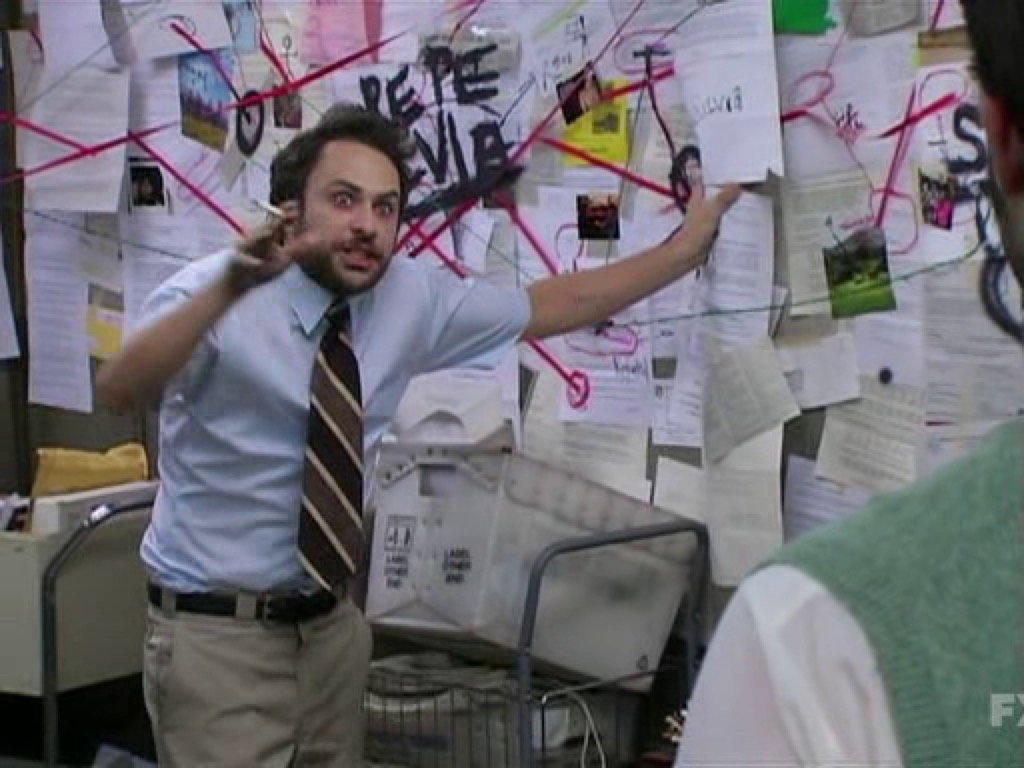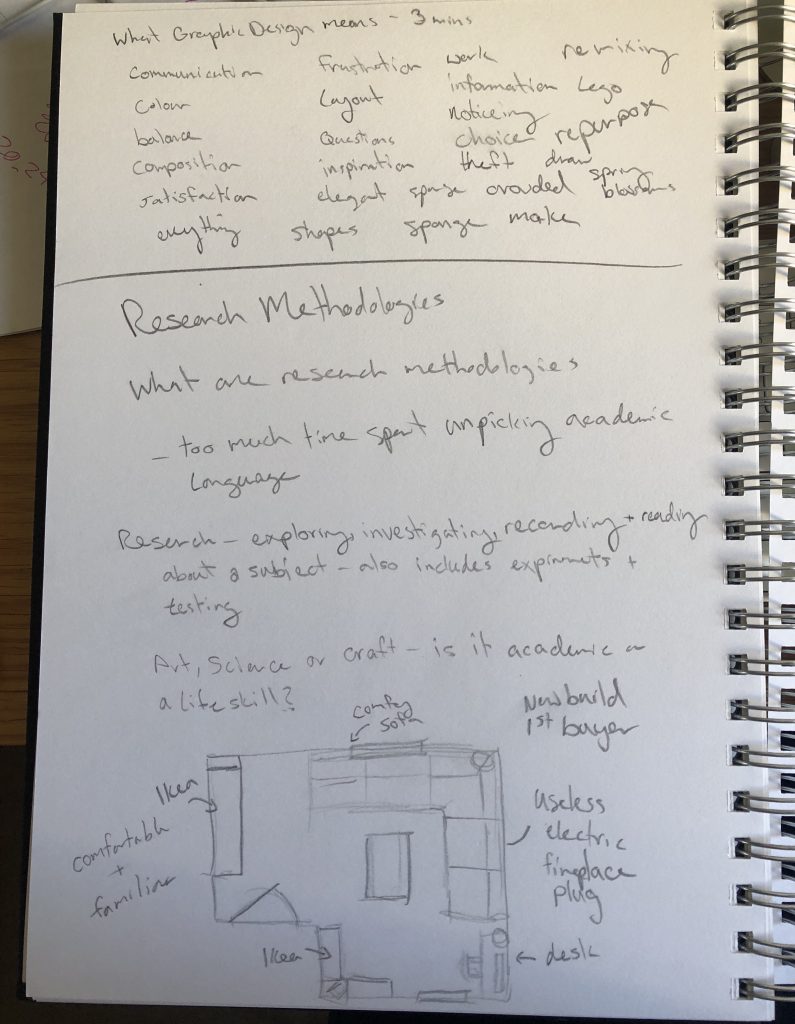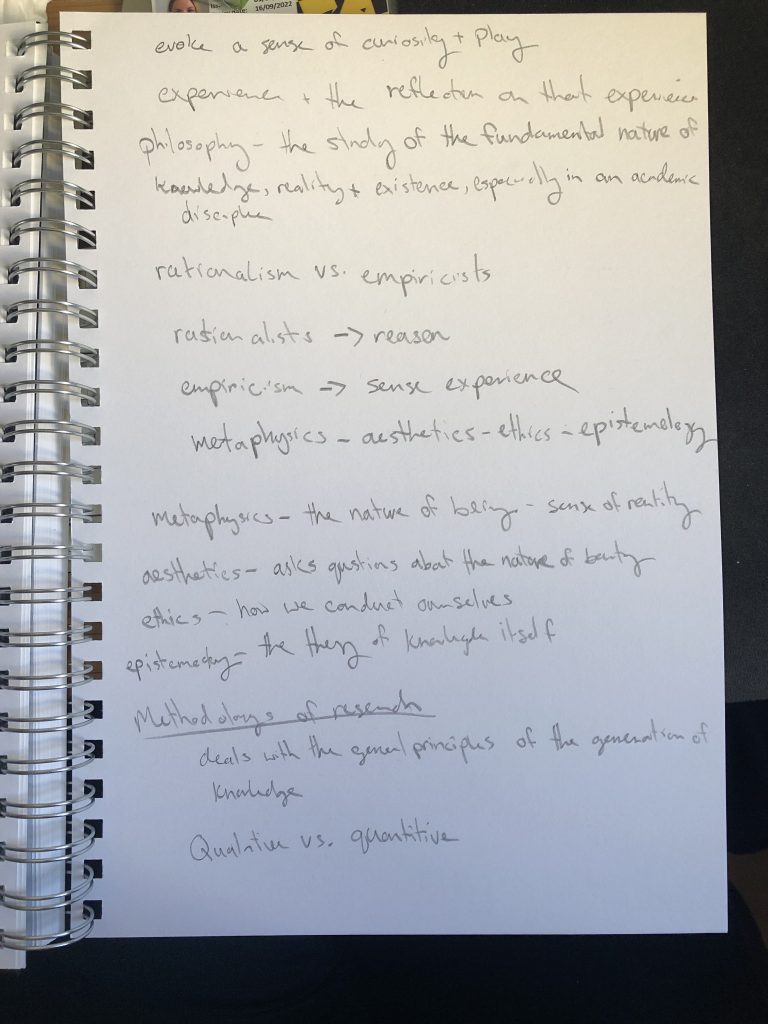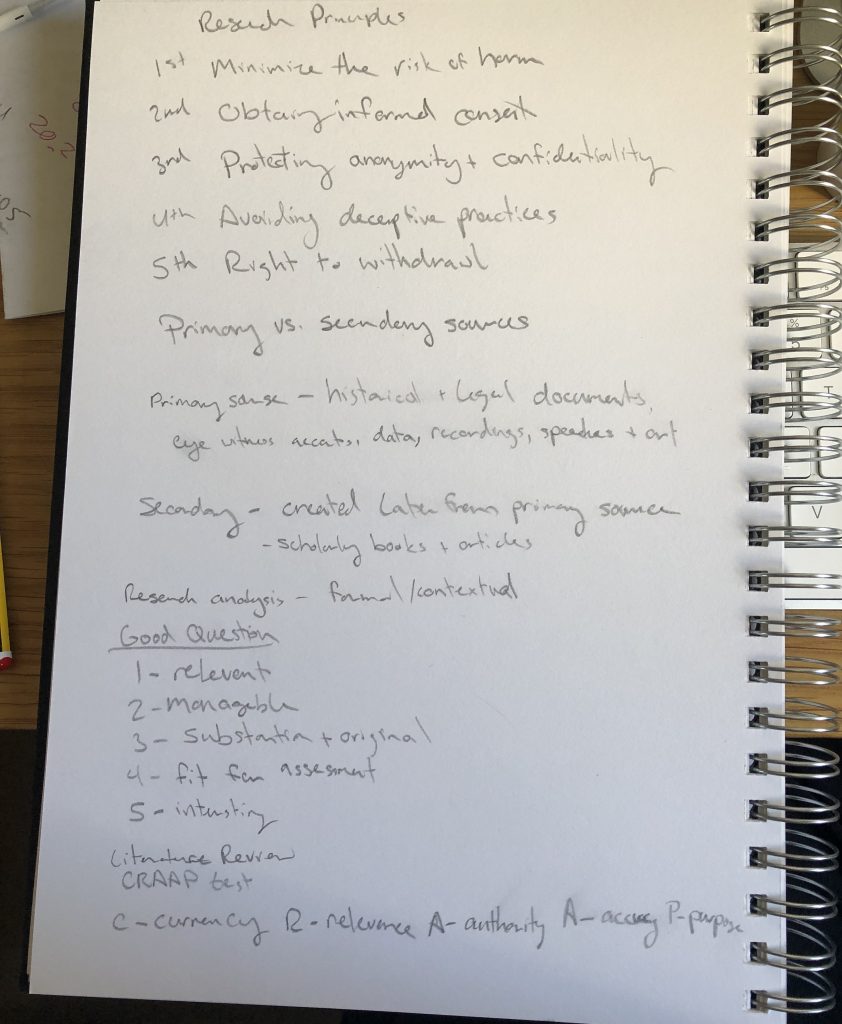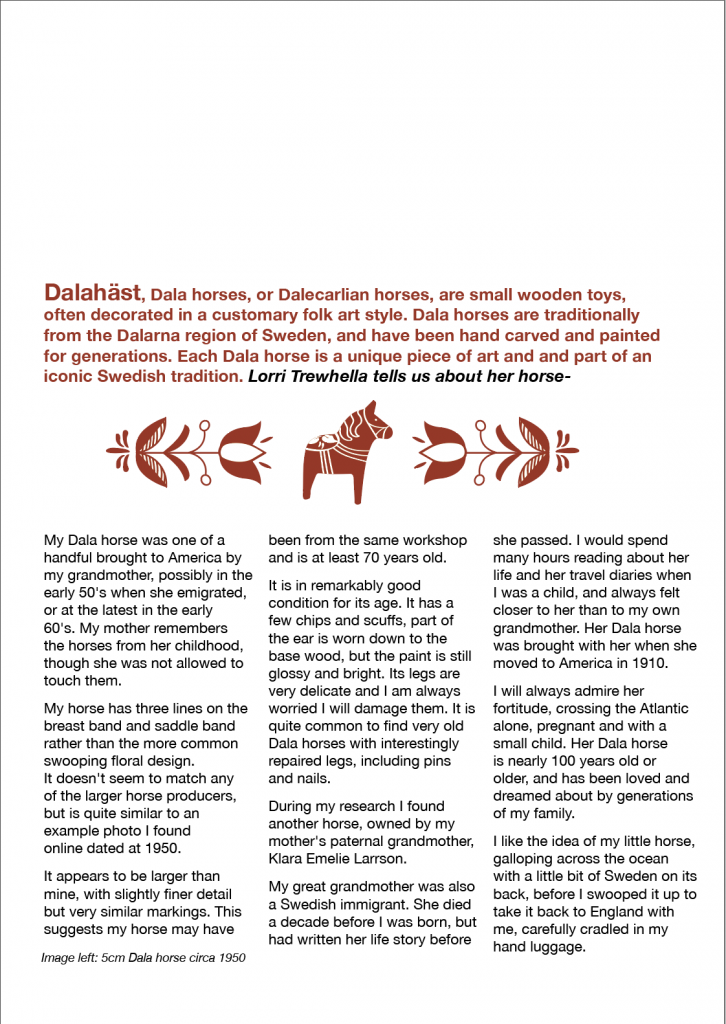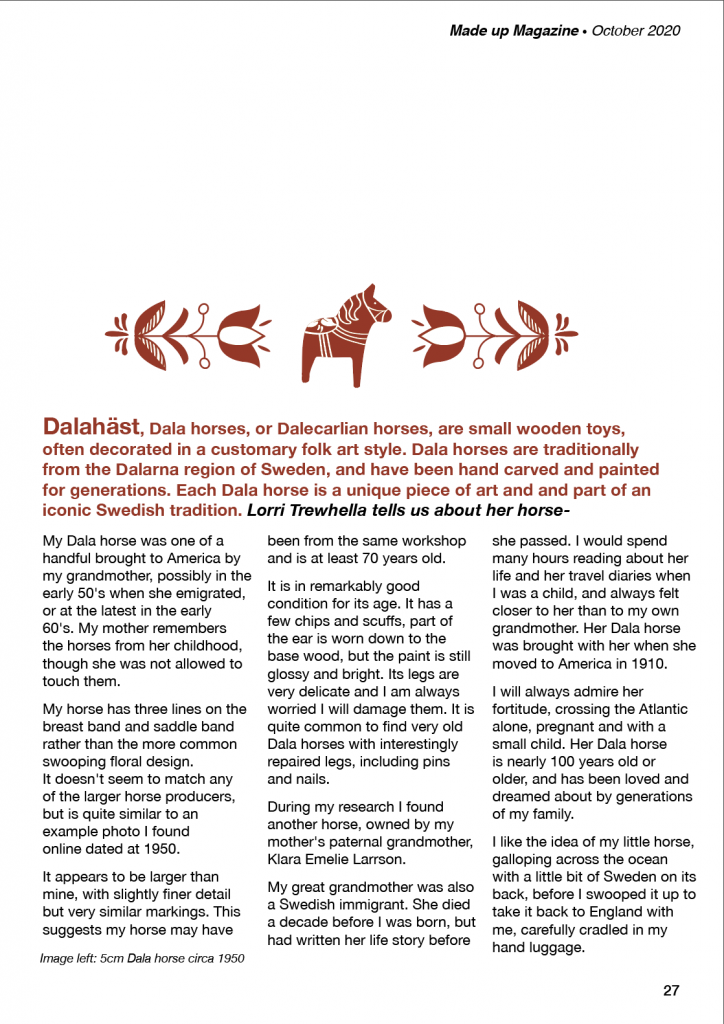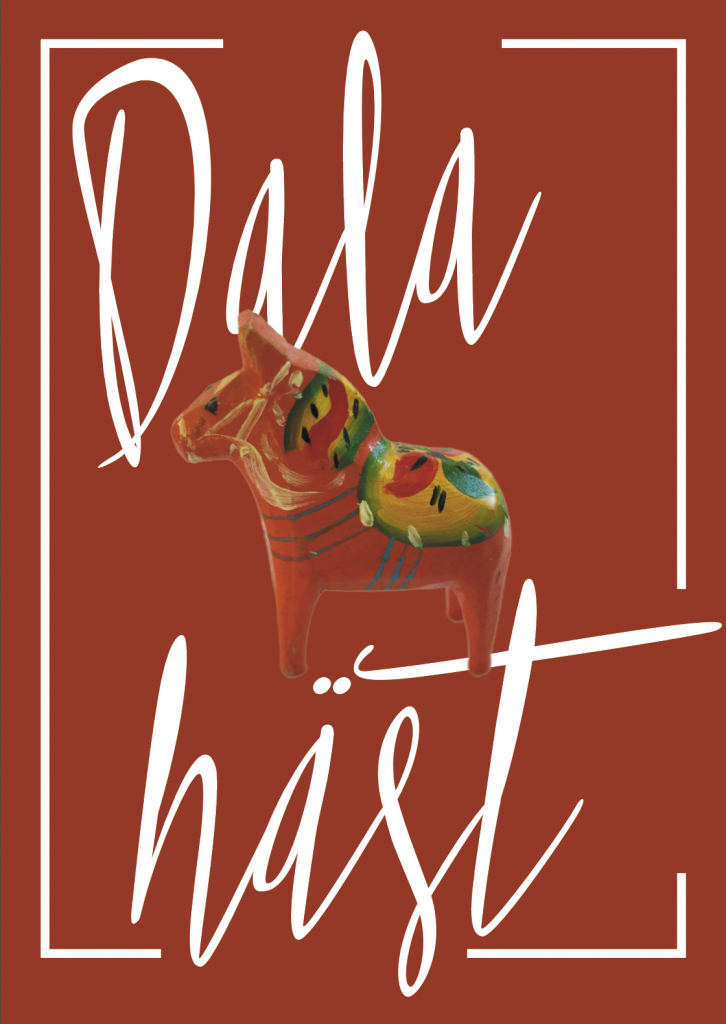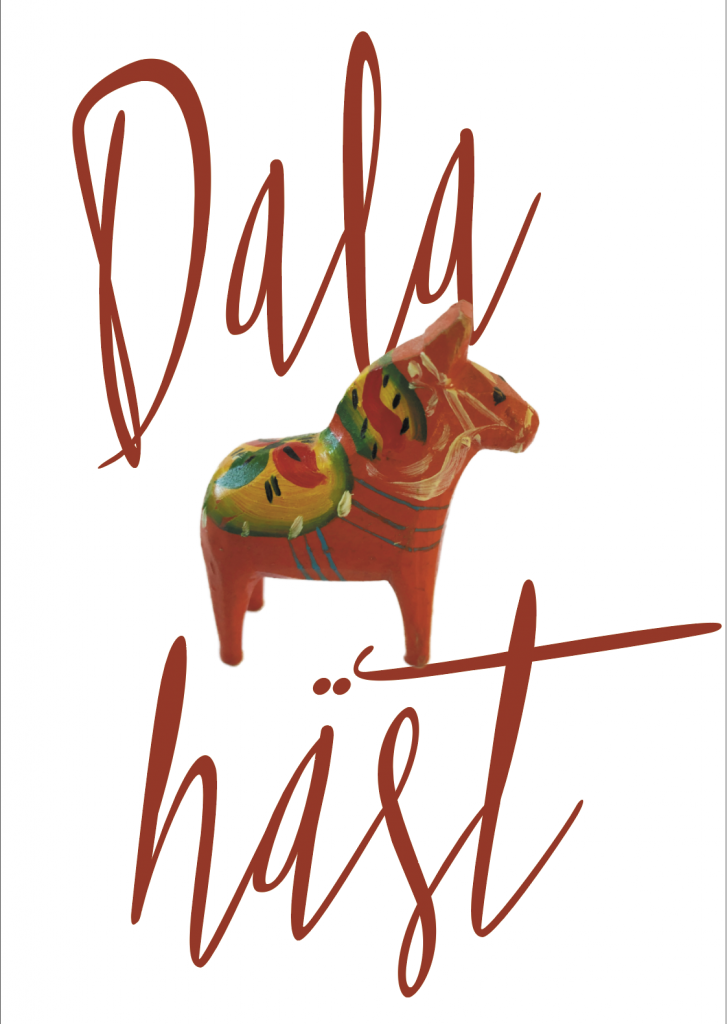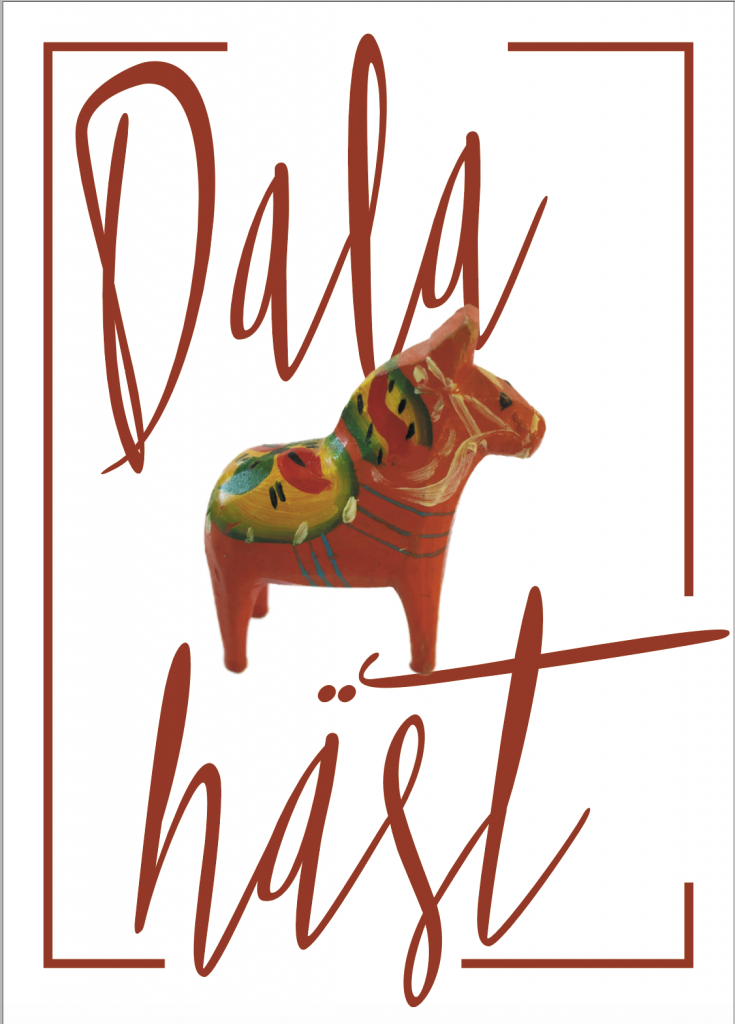Lecture by Martin Hosken
Design research: methods and perspectives by Brenda Laurel
Creative research: the theory and practice of research for the creative industries by Hilary Collins
Visual research: an introduction to research methodologies in graphic design by Ian Noble and Russell Bestley
I found this week’s resources to be more difficult to engage with. I don’t usually work with hard data driven projects, or if I do the data is supplied to me by a client. This chart from the Brenda Laurel book was very helpful to orient my preferences for research. I definitely fall on the right side of the chart, preferring qualitative research in both the visual and verbal spectrum.

A successful designer will use any tools available to inform their work, and research is a very powerful tool in their arsenal. This also ties in with the lessons we’ve learned in the past few weeks – collecting data and information will help engage with projects in new ways and develop new understandings rather than relying on assumptions or conjecture. I had to challenge some of my own assumptions this week, different approaches to research are more or less useful in the context of your initial question or desired outcomes. Areas of research I had not considered interesting or as valuable will be necessary in the correct context, and not something I should ignore.
I do see the value of quantitative research, especially for market research, UI/UX design and business purposes. During the lecture Martin Hosken also referred to a book by Thomas Cresswell (Hosken ND) which will be very useful for setting up data driven research questions in the future. I’ve come to the realisation that this is a skill I will need to develop, and this week has been a good initial grounding on the subject.
Bringing quantatitive research into the design process can inform choices, allowing you to bring more thought and planning into a project rather than design something and attempt to make it fit your needs afterwards. This chart gives helpful suggestions for where quantatitive research could be useful in the design process:
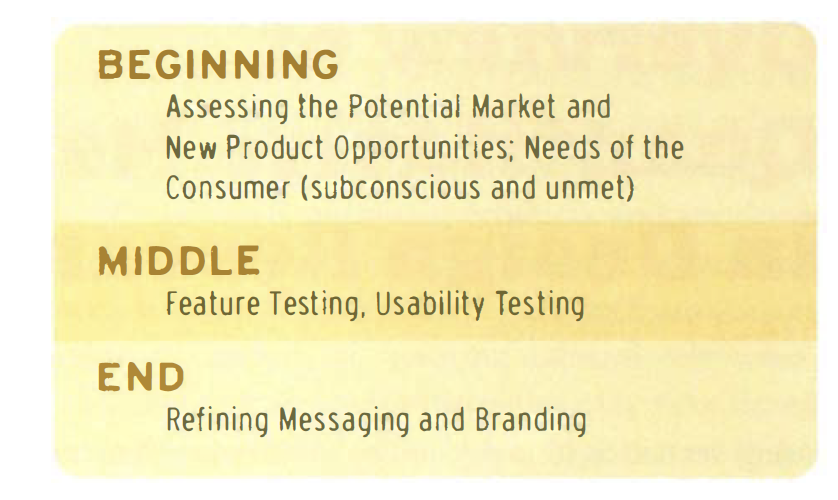
Beginning – Assessing the Potential Market and New Product Opportunities: Needs of the Consumer
Middle – Feature testing, Usability Testing
End – Refine Messaging and Branding
(Laurel, 2003)
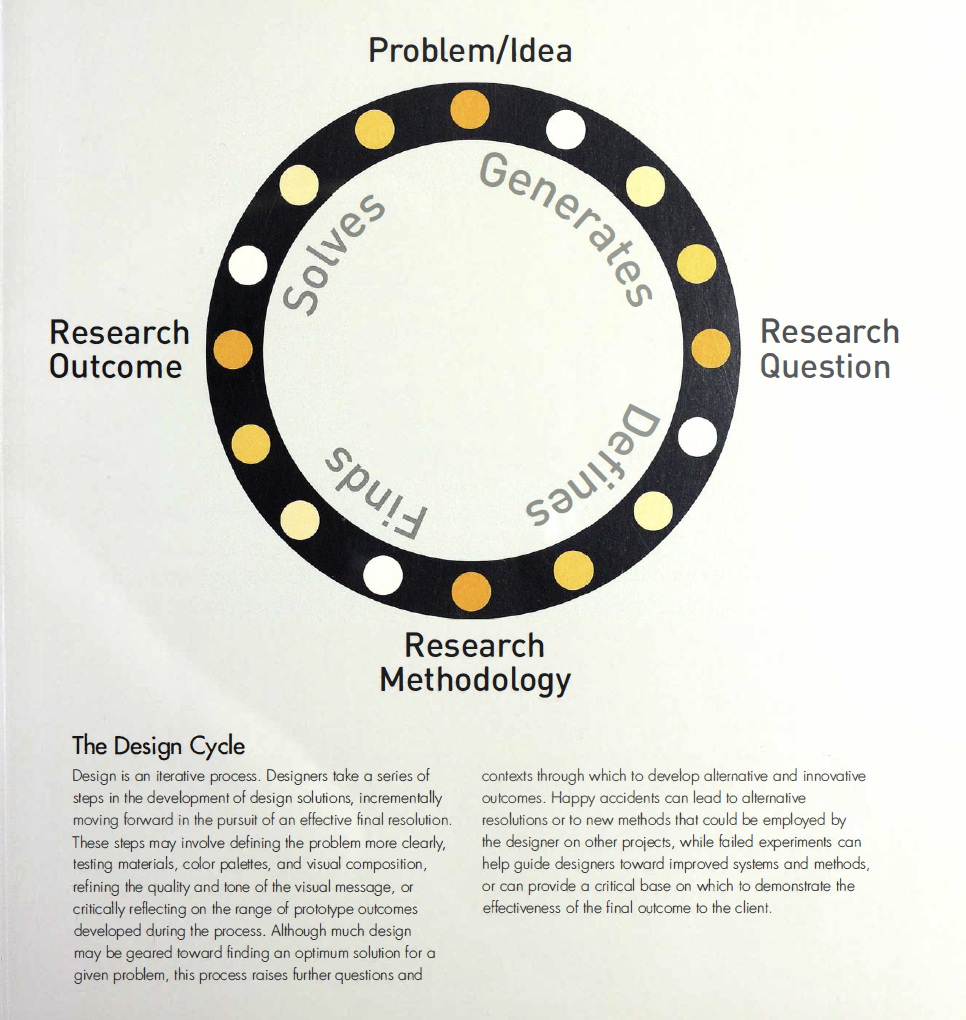
This chart from Ian Noble and Russell Bestley (Noble and Bestley 2016) brings research into the design cycle. Every stage of a project brings new questions, each iteration a branching path of questions.
I find research to be quite addictive, Hosken links curiosity, playful imaginative interaction and discovery of knowledge to research. (Hosken n.d.) This is how I fundamentally approach research, and as I am quite a naturally curious person I tend to research everything that catches my attention, unanswered questions are a challenge. My first instinct is to turn to books and resources, then to ask questions of people, seeking multiple views and trying to find a common thread I can follow. One question always leads to another, and if I’m lucky there will be a conclusion, that new knowledge Hosken speaks about.
Primary secondary tertiary sources.
The university library has suggestions for finding sources and information. It is very important to gather information from a wide variety of places, and to evaluate that information. It is easier than ever to find information, and a large part of research is evaluating and sorting information. Discarding information that is incorrect or simply not useful to you, and retaining that which is. Martin Hoskin covered the CRAAP test in this weeks lecture, as pertaining to setting up a research question. This method is also a useful way to evaluate sources.
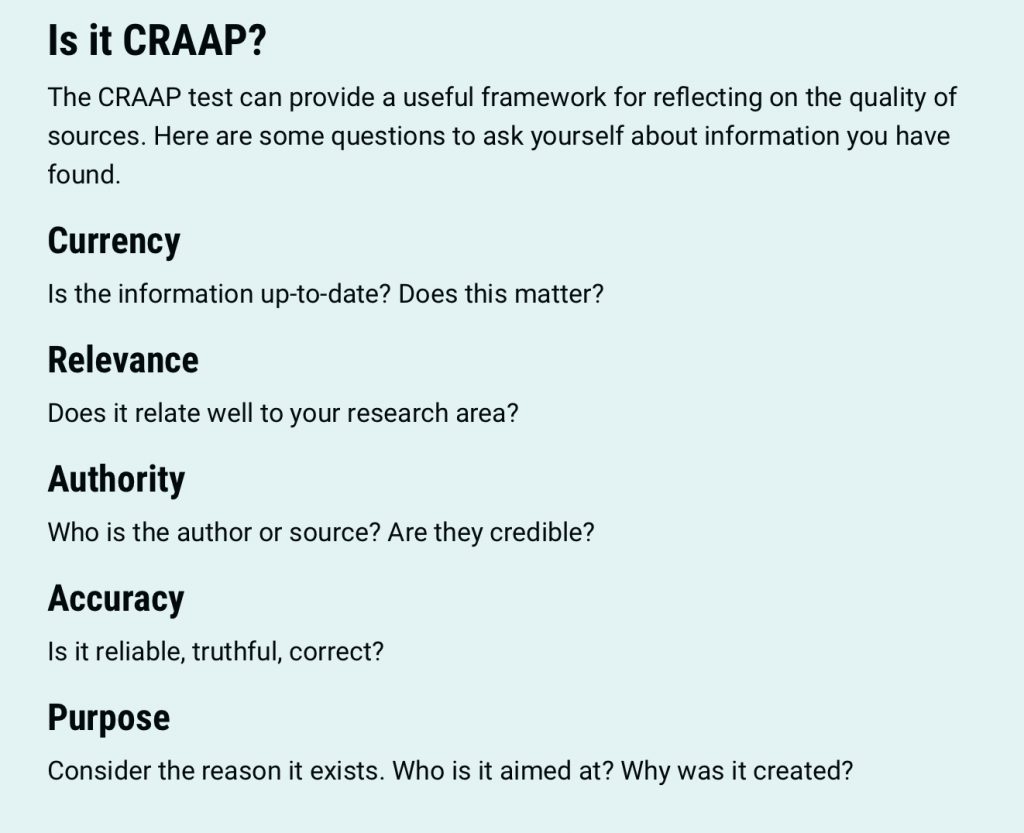
Not everything is a subjective, measurable, fact that is best recorded by quantatitive means. Not everything is best approached by purely qualatitive methods. Being aware of different methodologies helps you to choose the best approach for a particular question, and allows methods of research to inform and support one another.
Workshop challenge
Choose an object you feel has a story to reveal.
Write a 300 word text acknowledging the texts that link to your writing.
The object I’ve chosen is a small Dala horse.

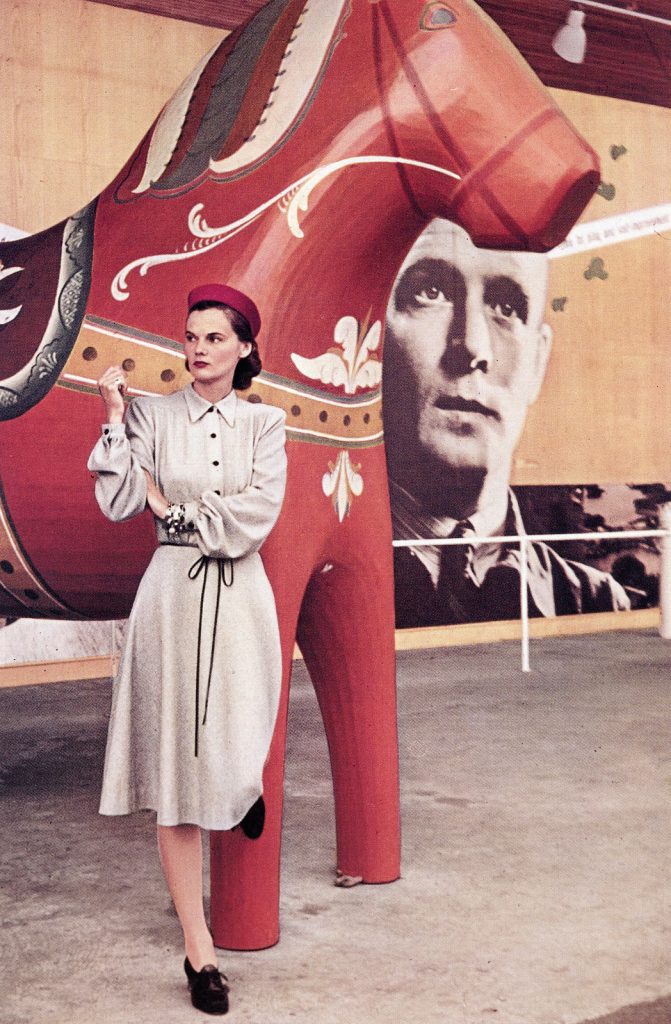
Dalahäst, Dala horses, or Dalecarlian horses, are small wooden toys, often decorated in a traditional folk art style called kurbits. Dala horses are traditionally from the Dalarna region of Sweden, and have been hand carved and painted for generations. There are many stories about their origin, but they have been traded throughout Sweden for many centuries, with entire families devoted to their production. Dala horses were so popular that they could be directly traded for goods and services. (Liljegren n.d.)
In 1939 a large Dala horse was included as part of the Swedish Pavilion at the World’s Fair, proving to be a popular draw, and they are now seen as a symbol of Sweden worldwide.
All Dala horses are hand made, even to this day. Tools and manufacturing processes have improved, but all horses are hand painted and unique. Modern horses are often rough cut with electric tools before being hand finished with traditional carving knives. They are then sanded, primed, and dipped in colourful paint before finally being decorated by skilled artisans in the kurbits style.
Older horses can even be identified by carving and painting styles. At dalahorse.info two collectors, Göran Samuelsson and Johan Nordström, have been attempting to identify the style of significant carvers and painters to make assessments of Dala horses easier. Each artist has their own style, horses from major manufacturers such as Grannas and Nils Olsen include more modern styles as well as special editions designed to mark occasions.
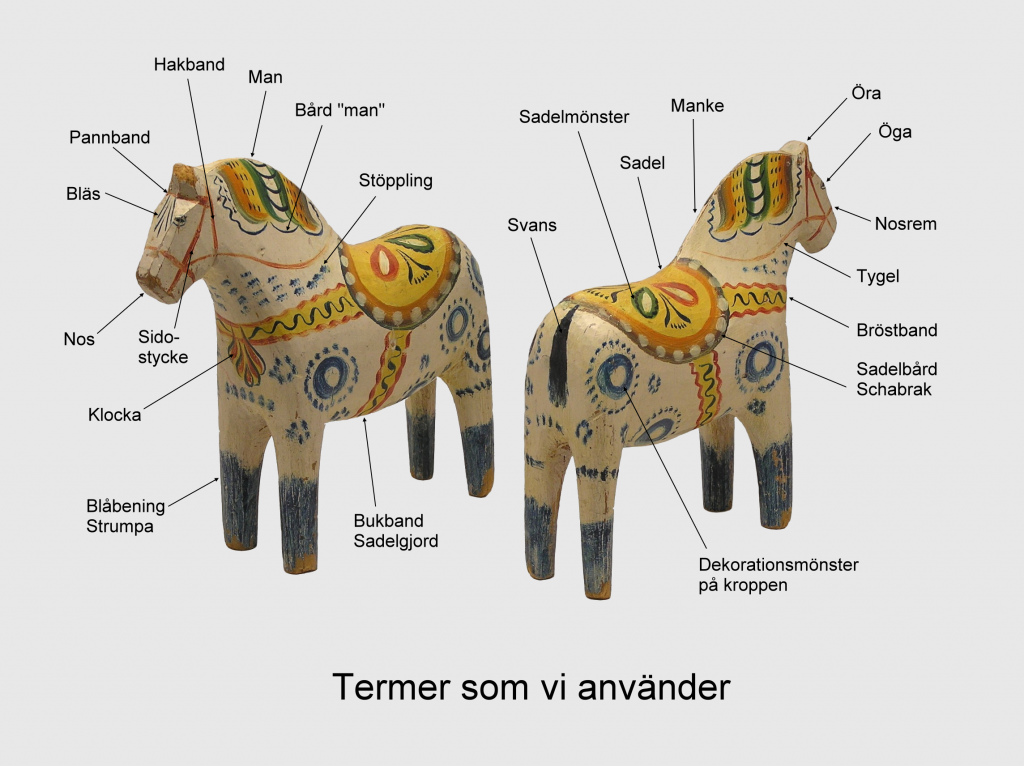
The most popular style of Dala horse is painted a warm red, a tradition dating back to the discovery of copper deposits in the Falun region. The apocryphal story asserts that a young goatherder become distressed when a billy goat, Kåre, would wander home with red bloodlike stains on his horns. (Kelleher, 2017) Following the goat, the young herder discovered he would rub his horns and coat against a glistening rock, which turned out to be large iron and copper deposits.

This site would become the famous copper mines of Falun, the source of much of Sweden’s wealth throughout the Middle Ages and the reason we have the term “barn red,” for it was here that Swedes discovered the preserving and protective properties of copper, iron ochre, silica, and zinc. Mixed with linseed oil, these minerals became a deep warm red paint, which was applied to the sides of houses and barns throughout Scandinavia and later, the east coast of America. – Katy Kelleher
My own Dala horse was one of a handful brought to America by my grandmother, possibly in the early 50’s when she emigrated, or at the latest in the early 60’s. My mother remembers the horses from her childhood, though she was not allowed to touch them. My horse has three lines on the breast band and saddle band rather than the more common swooping floral design. It doesn’t seem to match any of the larger horse producers, but is quite similar to an example photo I found from the Wikipedia entry on Dala horses and dated at 1950. It appears to be larger than mine, with slightly finer detail but very similar markings. Smaller horses are more difficult to carve and generally come out slightly blockier. This suggests my horse may have been from the same workshop and is at least 70 years old. It is in remarkably good condition for its age. It has a few chips and scuffs, part of the ear is worn down to the base wood, but the paint is still glossy and bright. Its legs are very delicate and I am always worried I will damage them. It is quite common to find very old Dala horses with interestingly repaired legs, including pins and nails.
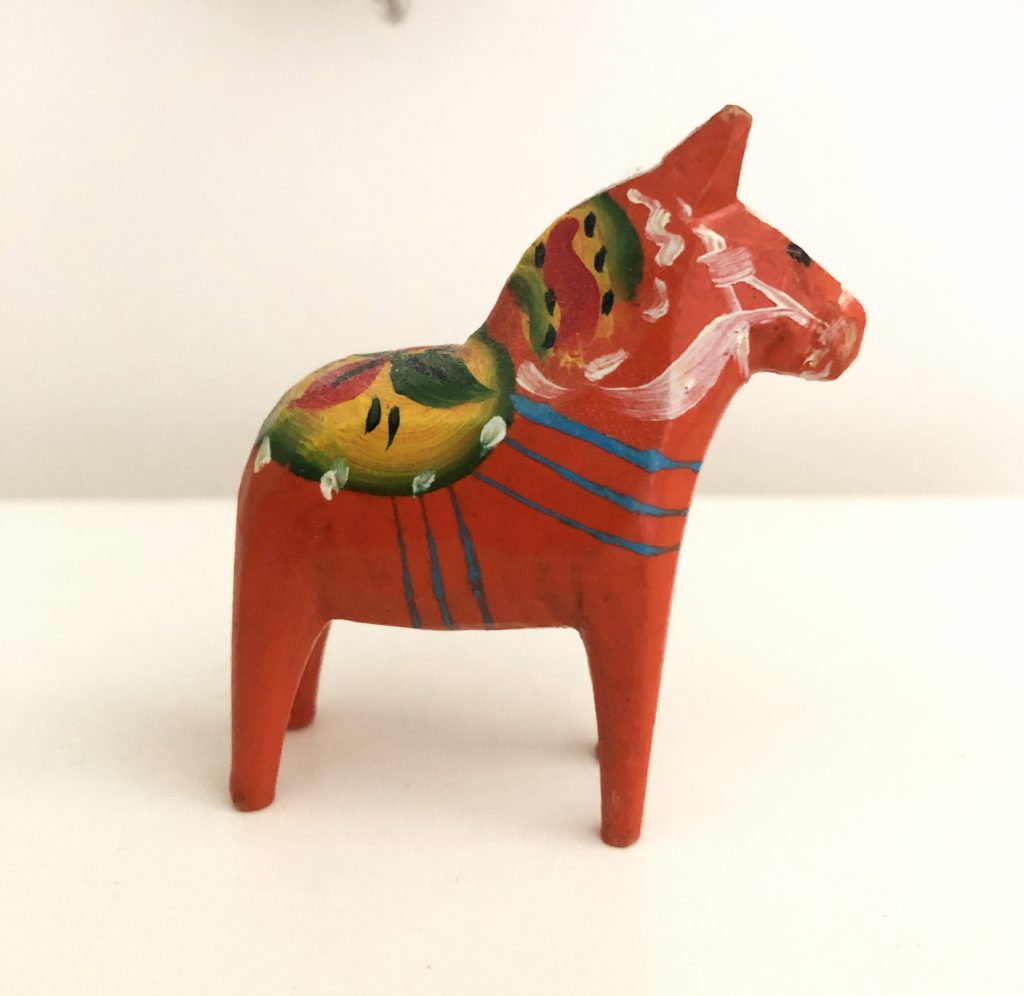
My Dala horse 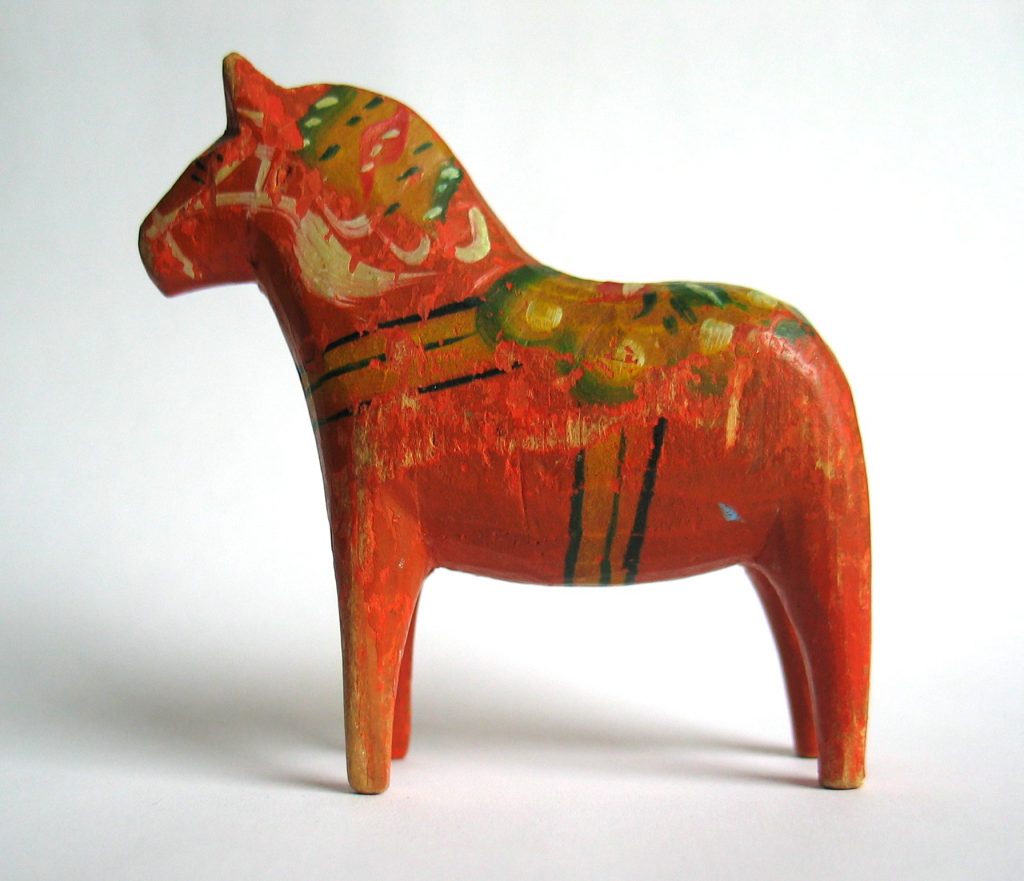
An example Dala horse from Wikipedia, dated around 1950
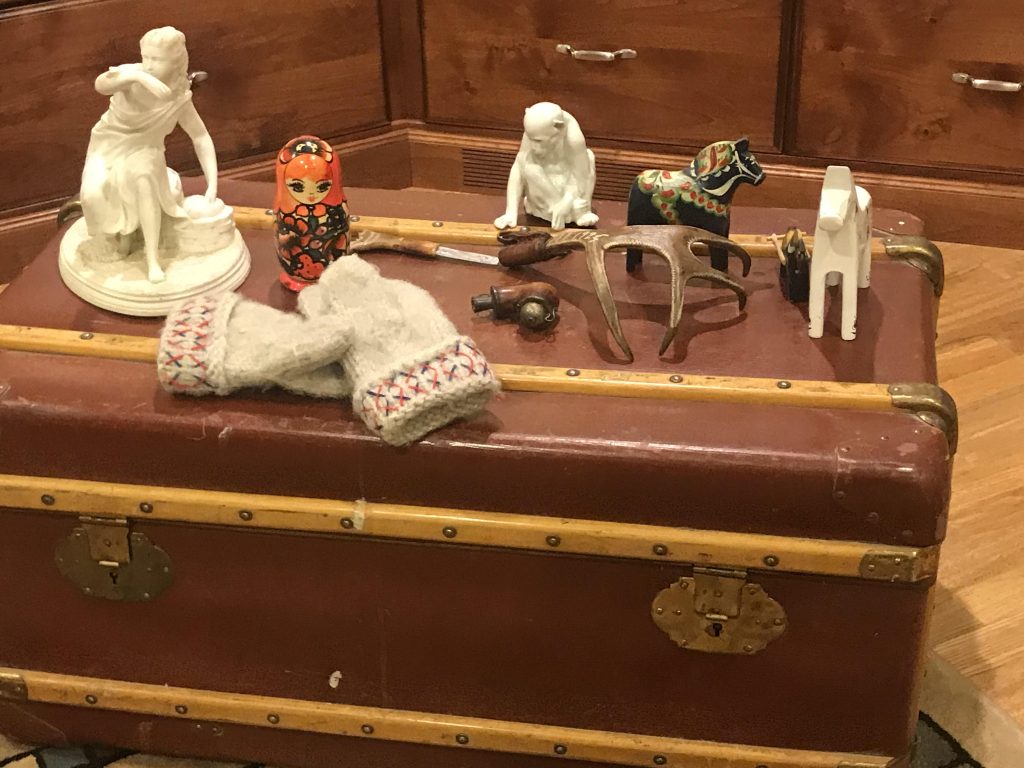
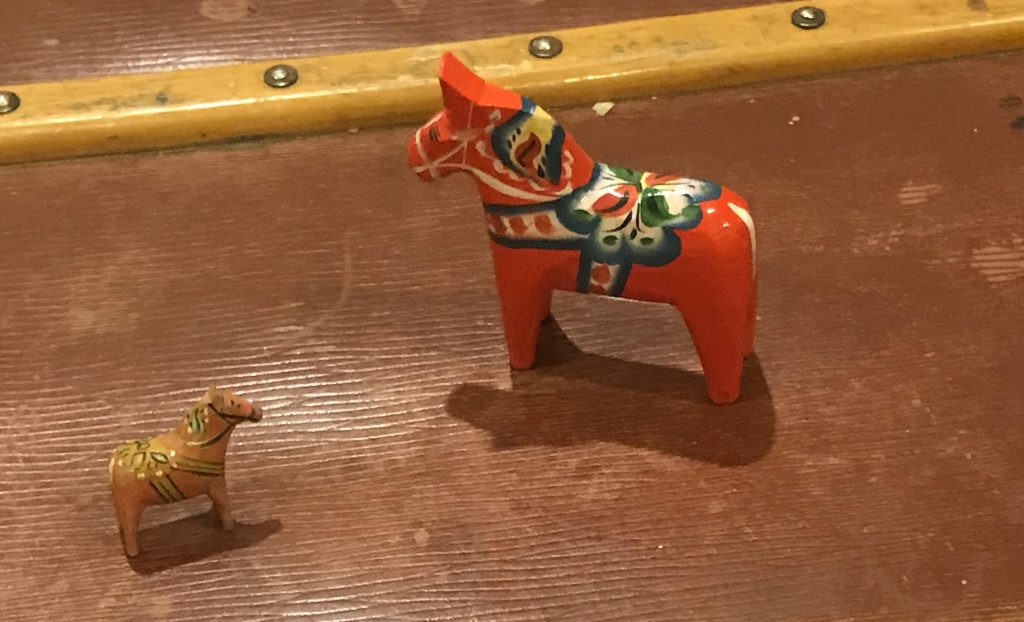
Two more Dala horses from my mother’s collection, the orange and gold horse on the left is even smaller than mine. There are quite a few other treasures passed down when my grandmother died, including a large breakfront cabinet, a beautiful Mora clock, reindeer mittens, pipes and snuffboxes, pewterwork and paintings.
During my research I found this horse, owned by my mother’s paternal grandmother, Klara Emelie Larrson.
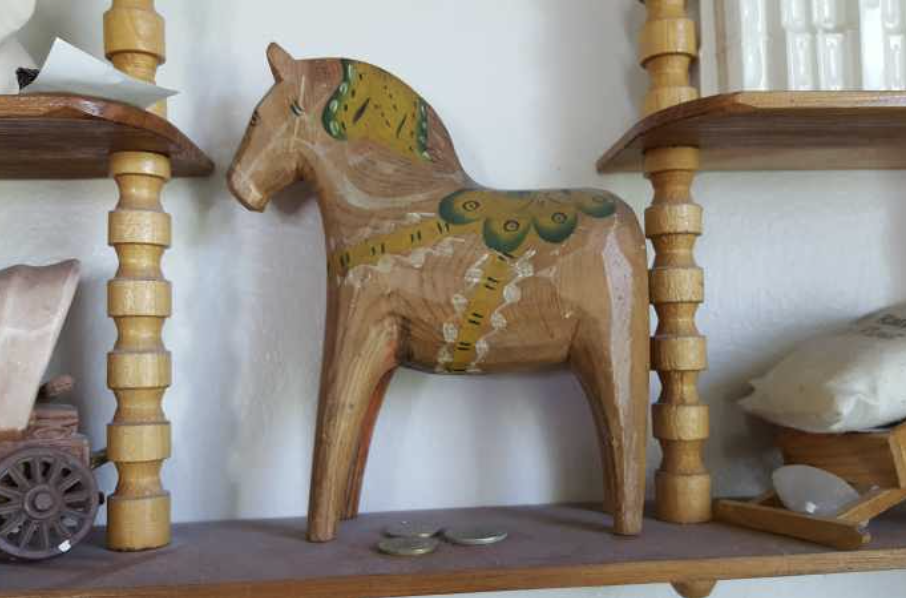
“The brown horse was hand carved and hand painted in Sweden, during the long winters, when the snow was high against the houses. It used to be bright orange, but the bright paint has faded in the intervening years. Grandma Emy Mitchell brought it with her to America around 1910, keeping it always on her mantlepiece at Christmas time. That same Dahla horse stands on Helen Mitchell’s knick-knack shelves. When Grandma Emy passed away, she left the Dala horse to Albert Wallace Mitchell Jr. who gifted it to Helen and Larry Mitchell later on. At first, Helen put it out during Christmas, before deciding to put it on display throughout the year. Even now, she calls it “a Christmas horse.” The edges of the Dahla horse are smooth, worn by many hands. Some of the orange paint can be seen in the creases and corners, hidden safely from children’s hands. The wood stain is largely intact, and the swirling wood grain shines dully beneath the bits of paint. Part of the ears have been re-glued, and the horse has a few scratches, a few cracks, but the horse is still in very good condition. I love the graceful arc on the horse’s neck, the faceted design of the horse’s muzzle, and the smooth, worn texture of the wood. The current year is 2020, but this horse has been in our family at least since 1910. The other two horses were brought as presents from Albert and Geneva’s vacation to Sweden, accompanied by Aunt Elaine. They gave a Dahla horse to each of their children and grandchildren. The red and blue Dahla horses were the ones given to Helen and Larry Mitchell. At the time, Uncle Wallace was living in Ireland.”
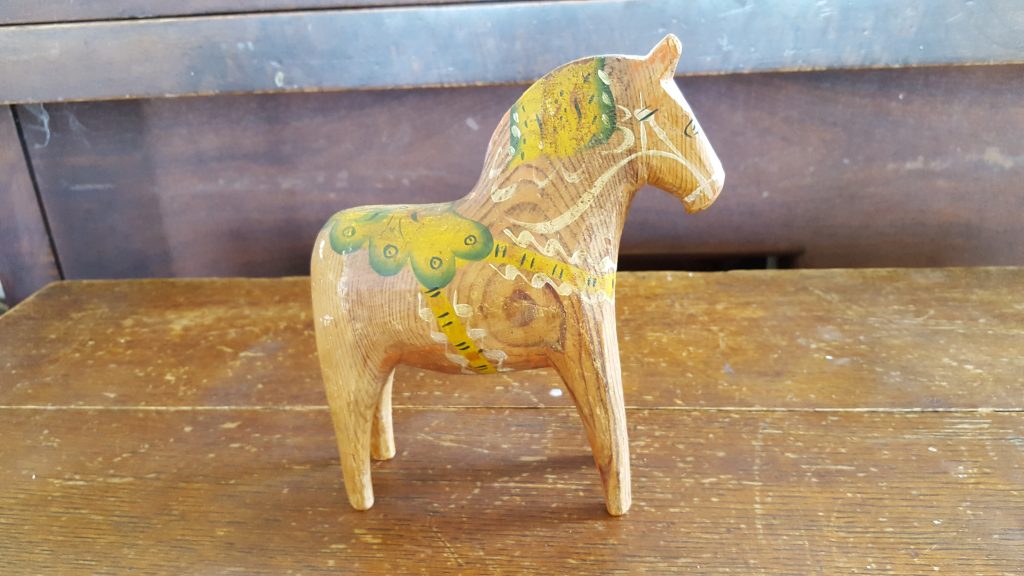
My great grandmother was also a Swedish immigrant. She died a decade before I was born, but had written her life story before she passed. I would spend many hours reading about her life and her travel diaries when I was a child, and always felt closer to her than to my own grandmother. This Dala horse was brought with her when she moved to America in 1910. I will always admire her fortitude, crossing the Atlantic alone, pregnant and with a small child. Her Dala horse is nearly 100 years old or older, and has been loved and dreamed about by generations of my family. I like the idea of my little horse, galloping across the ocean with a little bit of Sweden on its back, before I swooped it up to take it back to England with me, carefully cradled in my hand luggage.
When looking into my Dala horse a combination of research techniques were used including: observation, a 1 on 1 interview, and historical research, both to look into the history of Dala horses in general and the history of my particular Dala horse. While doing this I also found interesting information about linked topics such as Falun red, found a second cousin once removed I had never met before, accessed historical documents in Sweden and uncovered more questions about my family to research further.
I knew I wanted to include a kurbits style design in the final editorial piece. I started trying to draw elements for this in Illustrator on the ipad. This is a new app, and I can’t quite get the hang of it. A lot of tools I’m used to using in the desktop version are missing or don’t work quite the same way. It was only released this October, so I’m sure new updates and more practice will make this easier to use. The pencil is very smooth and if they would let you redraw a path or use the pencil smooth tool it would be very useful to my workflow. As it was, I found myself getting very frustrated! Luckily, the apps are interactive, so I was able to directly take the file from my ipad –
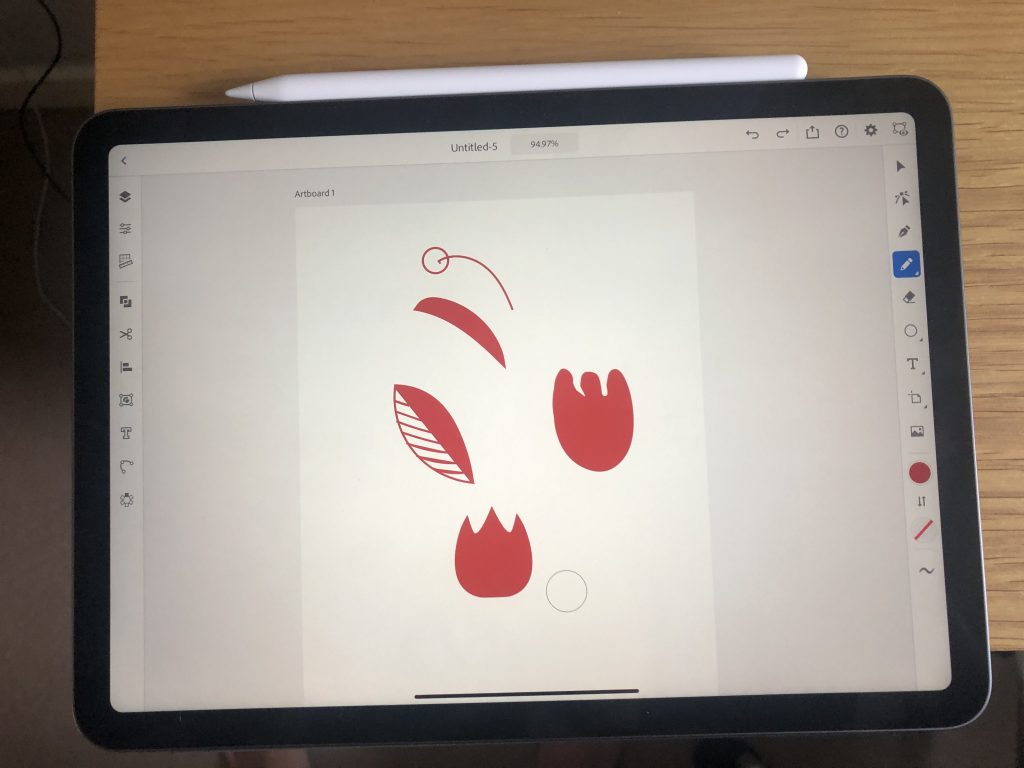
to my desktop via Creative Cloud. I drew a stylized version of my Dala horse, alongside repeat floral elements. I took the colour directly from my horse, noticing that it was also Falun red. Scandinavian style is now known for being clean and modern, with bold geometric patterns and lots of white space.
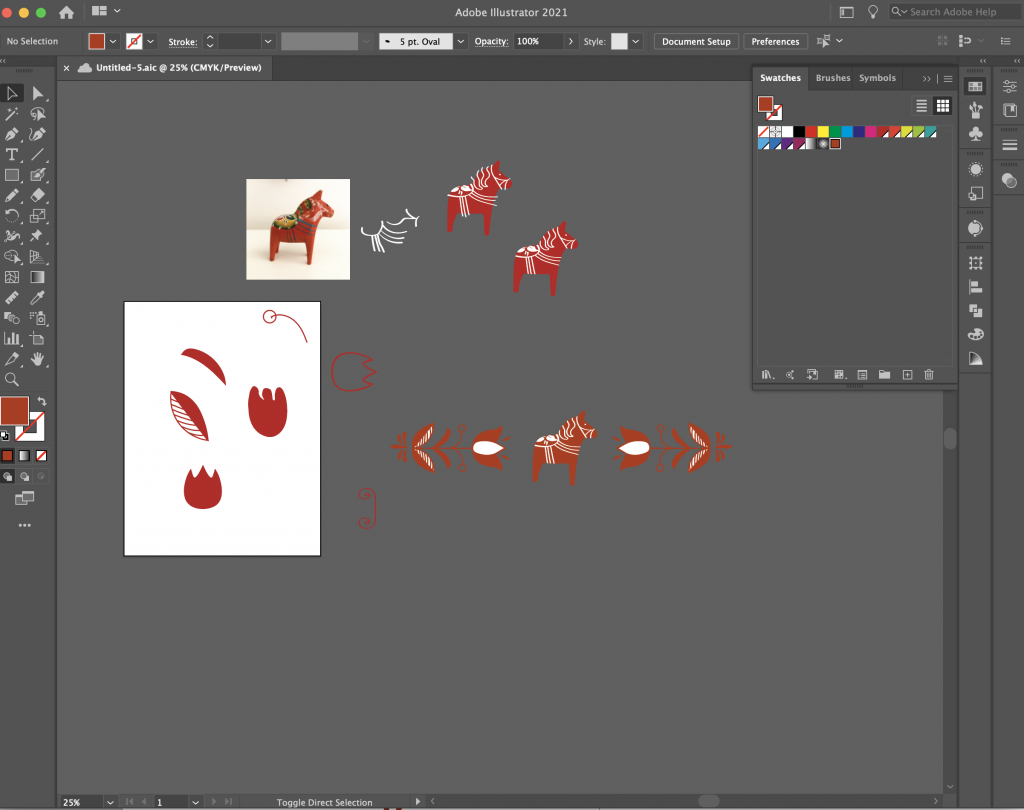
I find this very interesting, as traditional Swedish folkart is so full of explosive florals, detailed patterns, scrollwork and decorative elements. This is found not only on Dala horses, but furniture, embroidery, clothing, and painted elements in homes. Åse Larsjos is a modern kurbits painter, offering workshops and tutorials as well as commissions such as traditional vestibule decoration on homes.
I set the text very plainly, wanting the combination of a stripped back modern style, white space, and more traditional patterns, using Falun red to draw your eye. I also wanted to split the small introduction about Dala horses with the more personal reflections on my particular horse, so I created a mock magazine and splitting the text between introduction and interview.
I tried several designs for the facing page, and posted them on the ideas wall.

I was concerned that the red background overwhelmed the Dala horse, but the feedback I got unanimously preferred it.
After a tutorial session with Harriet, I changed the font to a smaller and more delicate serif, removed the framing around the page and brought the decorative elements across the spread.
Summary
This week was a mix of struggling to engage with the resources, and engaging too fully with the research project. I very much enjoyed discovering new things about my family history, Swedish folk art, Falun red, apocryphal stories including goats, horse spirits, different styles and types of Dala horses, photos of my great grandfather I’d never seen before, stories from my mother about her childhood and all manner of interesting things. Research, for me, is about balancing my curiosity with academic needs, and about recording and evaluating information and sources. I have also become aware of a deficit in my research experience, and the need to develop more quantitative skills when the need arises.
References
“Billy Goat Kåre | World Heritage Journeys of Europe.” 2020. Visitworldheritage.com [online]. Available at: https://visitworldheritage.com/en/eu/billy-goat-k%C3%A5re/78a3447a-8f0a-4ba2-81fa-303554fc7615 [accessed 4 Nov 2020].
COLLINS, Hilary. 2010. Creative Research : The Theory and Practice of Research for the Creative Industries ; Requireed Reading Range, Module Reader. London ; Oxford ; New York ; New Delhi ; Sydney Bloomsbury.
“Dalahästen – En Kulturskatt.” 2010. Dalahorse.info [online]. Available at: http://www.dalahorse.info/index.php/Huvudsida [accessed 3 Nov 2020].
“Evaluating Information | StudyHub.” 2020. studyhub.fxplus.ac.uk [online]. Available at: https://studyhub.fxplus.ac.uk/study-guides/research-finding-information/evaluating-information [accessed 8 Nov 2020].
“FamilySearch.org.” 2015. Familysearch.org [online]. Available at: https://www.familysearch.org/tree/person/memories/KWZD-842 [accessed 3 Nov 2020].
“File:Falu Rödfärg.JPG – Wikimedia Commons.” 2008. Wikimedia.org [online]. Available at: https://commons.wikimedia.org/w/index.php?curid=4790588 [accessed 5 Nov 2020].
GÖRAN FRANZÉN. 2013. “Dalahästar Sweden.” YouTube. Available at: https://www.youtube.com/watch?v=yyu1yFzTdlw&feature=youtu.be [accessed 5 Nov 2020].
GRANNAS. 2020. “World Expo 1939 – Grannas A. Olsson Hemslöjd AB.” Grannas.com [online]. Available at: https://www.grannas.com/en/content/11-world-expo-1939 [accessed 5 Nov 2020].
HOSKEN, Martin. 2020. Week 7 Guest Lecture Research Methods [lecture]. GDE710 for MA Graphic Design. Falmouth: Falmouth University 2020 [Accessed 3 Nov 2020]
KELLEHER, Katy. 2017. “Falu Red, The Color of Bucolic Barns and Mummified Swedes.” The Awl [online]. Available at: https://www.theawl.com/2017/12/falu-red-the-color-of-bucolic-barns-and-mummified-swedes/ [accessed 4 Nov 2020].
LAGO, Don and Inc EBRARY. 2004. On the Viking Trail : Travels in Scandinavian America. Iowa City: University Of Iowa Press.
LAUREL, Brenda. 2003. Design Research : Methods and Perspectives. Cambridge, Mass: Mit Press.
MINI, Annika. 2020. “Dala Horse or Dalecarlian Horse – a Treasure of Dalarna, Sweden – Finally Lost.” Finally Lost [online]. Available at: https://finallylost.com/dala-horse-or-dalecarlian-horse-a-treasure-of-dalarna-sweden/ [accessed 3 Nov 2020].
NOBLE, Ian and Russell BESTLEY. 2016. Visual Research : An Introduction to Research Methodologies in Graphic Design. New York: Fairchild Books.
PATTERNS OF EUROPE. 2017. “The Horse from Dalarna That Became a Symbol of Sweden – an Interview with Christiana Liljegren Form Grannas A Olsson Company | Patterns of Europe.” Patternsofeurope.pl [online]. Available at: http://patternsofeurope.pl/dala-horse/ [accessed 5 Nov 2020].
PIER, Meg. 2020. “Symbol of Swedish Identity, Dalahast Horse or Dala Horse.” Best Cultural Destinations [online]. Available at: https://www.bestculturaldestinations.com/the-dalahast-or-swedish-dala-horse-and-swedish-identity/ [accessed 3 Nov 2020].
SVT NYHETER. 2020. “Gammal Dalahäst Funnen Vid Utgrävning i Centrala Falun.” SVT Nyheter [online]. Available at: https://www.svt.se/nyheter/lokalt/dalarna/gammal-dalahast-funnen-vid-utgravning-i-centrala-falun [accessed 5 Nov 2020].
THE LOCAL. 2014. “The Story of a Swedish Symbol.” Thelocal.se [online]. Available at: https://www.thelocal.se/20141010/the-story-of-a-swedish-symbol-tlccu [accessed 3 Nov 2020].
VISIT WORLD HERITAGE. 2020. “The Story of the Dala Horse | World Heritage Journeys of Europe.” Visitworldheritage.com [online]. Available at: https://visitworldheritage.com/en/eu/the-story-of-the-dala-horse/68071977-c2ef-46f2-9aca-1b1c762eb6e1 [accessed 3 Nov 2020].
VOGEL, Teri. 2020. “LibGuides: CHEM 6C: General Chemistry III (Brydges, Spring 2020): Primary, Secondary & Tertiary Sources.” ucsd.libguides.com [online]. Available at: https://ucsd.libguides.com/chem6c/sources [accessed 8 Nov 2020].
WIKIPEDIA CONTRIBUTORS. 2020a. “Dalecarlian Horse.” Wikipedia [online]. Available at: https://en.wikipedia.org/wiki/Dalecarlian_horse [accessed 3 Nov 2020].
WIKIPEDIA CONTRIBUTORS. 2020b. “Falu Red.” Wikipedia [online]. Available at: https://en.wikipedia.org/wiki/Falu_red [accessed 4 Nov 2020].
WIKIPEDIA CONTRIBUTORS. 2020c. “Dalecarlian Horse.” Wikipedia [online]. Available at: https://en.wikipedia.org/wiki/Dalecarlian_horse#/media/File:Dalecarlian_horse.jpg [accessed 4 Nov 2020].
WOODEN HORSE MUSEUM. 2013. “Wooden Horses, Why, How, When?” Woodenhorsemuseumsweden.se [online]. Available at: https://www.woodenhorsemuseumsweden.se/ [accessed 4 Nov 2020].
